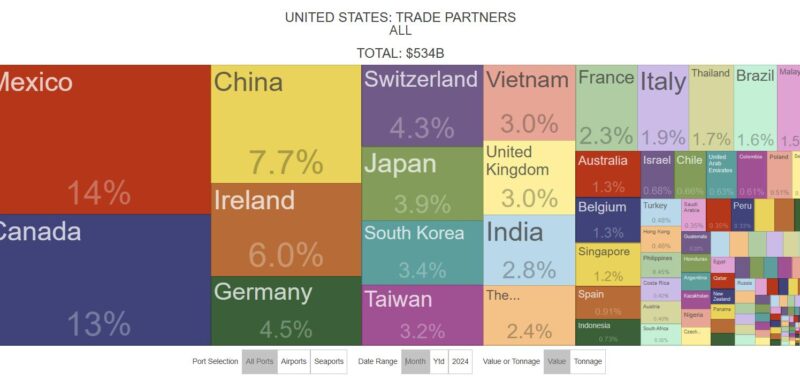China’s trade with the United States has not been this low in the last 264 months.
China’s percentage of U.S. trade hit the lowest level in 22 years, according to my analysis of the latest U.S. Census Bureau data.
And that was for the month of March – before President Trump’s April 2 “Liberation Day,” which started the process that eventually sent U.S. tariffs on Chinese imports to 145%, essentially embargo territory.
While those tariffs have been reduced dramatically in recent days, at least temporarily to 30%, they escalated quickly during the month of April, with China’s retaliation met by retaliation from the United States.
In March, China accounted for 7.65% of all U.S. trade. The only other month lower in the last 264 months was in March of 2003, when the total was 7.40%.
As recently as March of 2020, China accounted for 18.08% of U.S. trade, though that was at the onset of Covid-19, when China became the go-to source for masks, gloves and other supplies related to the pandemic. A more reliable historical perspective would be the second six months of 2017. From July through December, China accounted for more than 17% of U.S. trade, just prior to the onset of the tariffs Trump put in place during his first term in office.
I wouldn’t expect a reversal of the trend in April, when that data is released next month, since that’s when the tariffs went skyward, and wouldn’t’ expect much of one in May, given the nature of trade between the two nations.
Air cargo is much easier to adjust quickly, given the transport time. But most of China’s trade with the United States is by ocean. By value, China’s ocean cargo imports are worth more than twice that of air cargo. By tonnage, it is more than 99% of the total.
If China accounts for less than 10% of U.S. trade by the time the May data is released, a strong possibility, it puts it on a path to finish with less than 10% of all U.S. trade for the first time since 2003 – the year of the current record monthly low.
That current monthly record low could easily be broken when the April data is released next month.
The more interesting question is how China is likely to respond.
Given that the tariffs Trump put in place during his first term were not removed by President Joe Biden during his four years in office, and that Trump’s second term doesn’t run out for the better part of four years, will that lead to a further shift in final manufacturing or assembly to Vietnam, Taiwan, Japan and, to a lesser extent, Mexico as occurred during his first term?
One thing the trade war with China has not done, however, is lower the U.S. trade deficit, one of the biggest irritants to Trump. The U.S. deficit – the value of imports over exports – has increased seven of the last eight years, topping $1 trillion all four years of the Biden presidency.
It looks like 2025 could be another record-setter. Through the first quarter of 2025, the U.S. deficit with the world was $425.49 billion. The 2024 total for the first quarter, which also set a record, was $248.24 billion.
More troubling should be the percentage of U.S. trade that is an export, the “balance of trade.” Over the years, the percentage of trade that is a U.S. export has changed only nominally, from 37 cents on the dollar in 2017 to about 41 cents more recently as exports increased more rapidly to 39 cents in 2024 as they increased a little less rapidly. Through the first quarter of this year, that figure dropped to 36 cents on the dollar.

